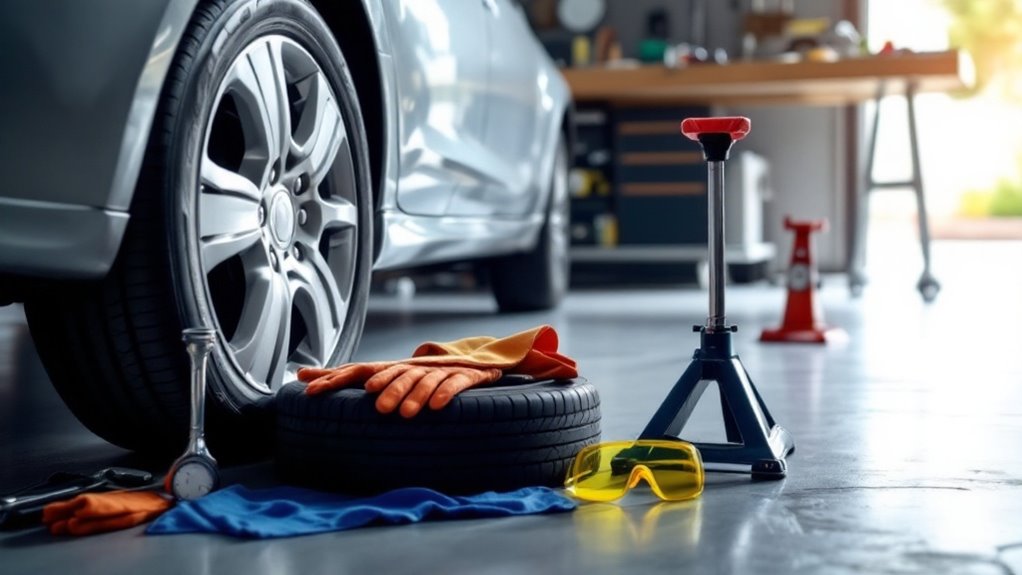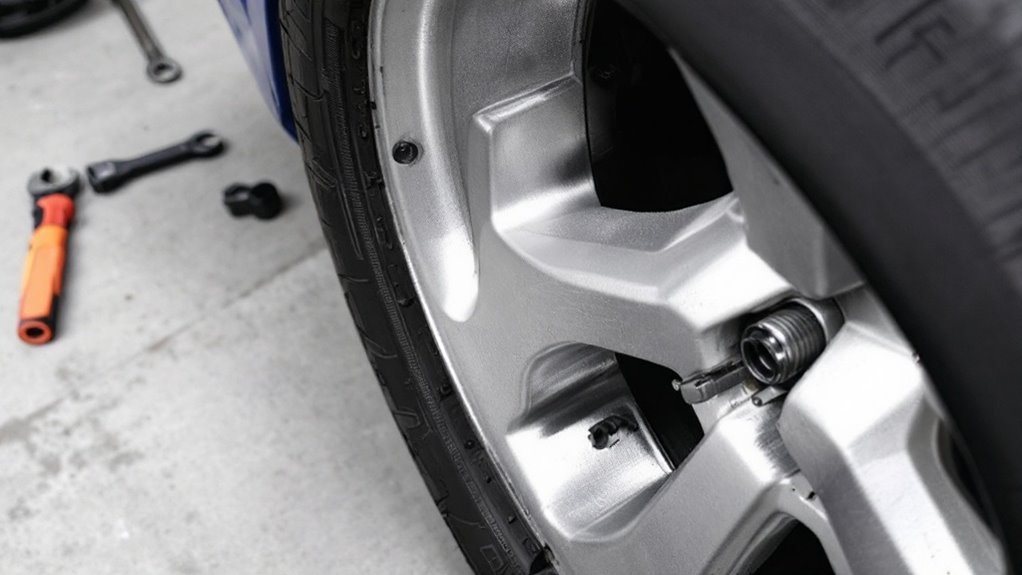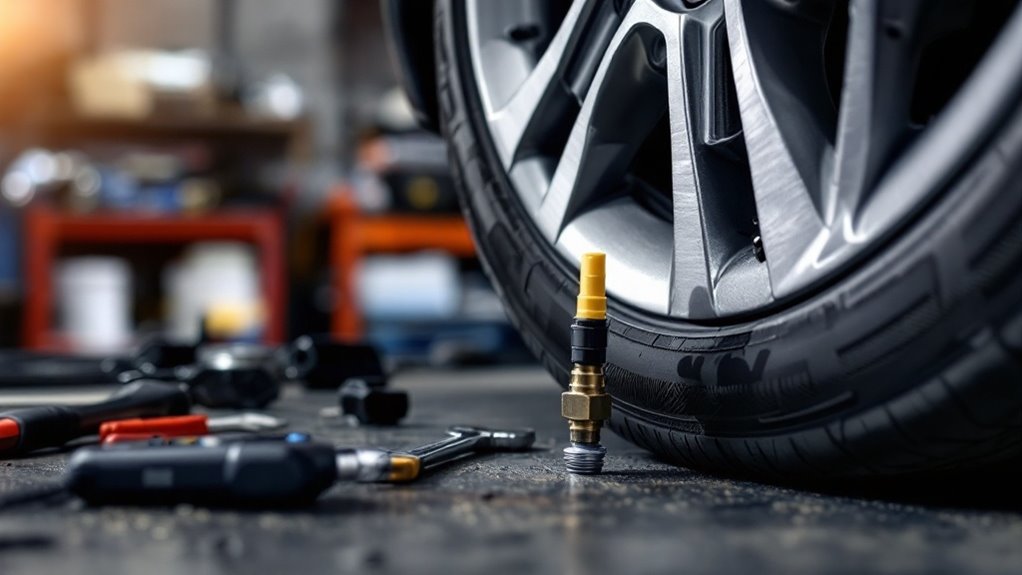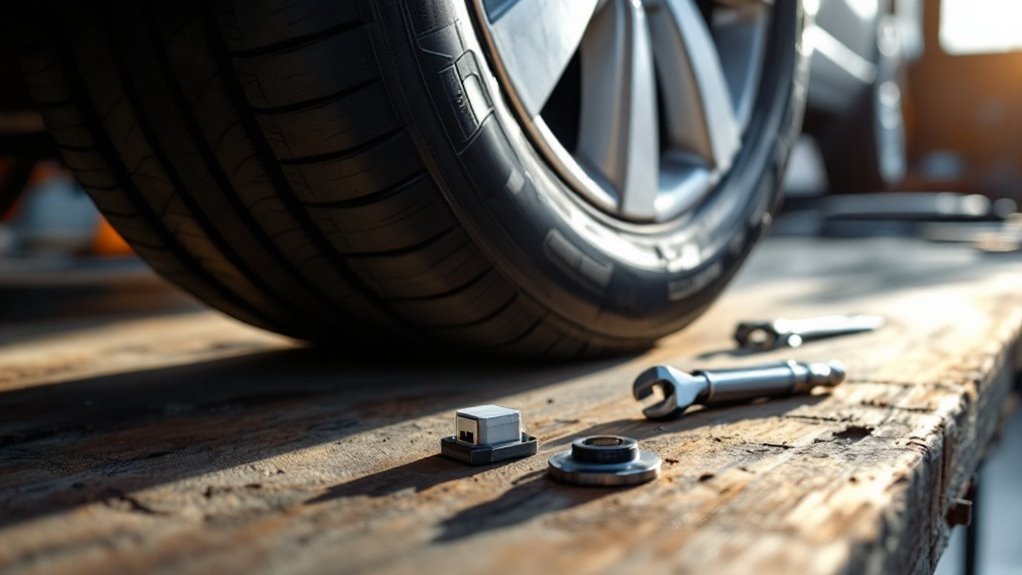Can I Replace Tire Sensor Myself
This post contains affiliate links. As an Amazon Associate, we earn from qualifying purchases.
You can replace a tire pressure sensor on your own. Got the right tools? Grab a valve core remover and torque wrench. A TPMS programming tool helps too. Stay safe first. Park on flat ground always. Use jack stands for support. Wear gloves and goggles for protection. Ready to start? Remove the wheel carefully. Deflate the tire next. Swap out the old sensor. Put in the new one. Reprogram it with an OBD tool. Need detailed steps? Check online guides for help. Got issues? Look up troubleshooting tips. You’ve got this!
Essential Facts in 30 Seconds
- You can replace a tire sensor yourself if you have the right tools and basic mechanical skills.
- Necessary tools include a valve core removal tool, socket set, and TPMS programming tool.
- Ensure safety by parking on flat ground and using jack stands during replacement.
- Programming the new sensor with a TPMS tool is required for it to work properly.
- Assess your skill level and consult your vehicle manual before attempting the replacement.
Understanding Tire Pressure Monitoring Systems
Tire Pressure Monitoring Systems, or TPMS, are super important for safety. They tell you about tire pressure right away. This keeps your car running well and safe. Low tire pressure can cause accidents. TPMS helps stop that by giving alerts. It also saves fuel and makes tires last longer.
Let’s talk about two main types of TPMS. First, Direct TPMS uses sensors inside the tires. These sensors give exact pressure numbers. Direct TPMS is generally more complex and higher in cost than indirect systems. Second, Indirect TPMS guesses pressure from wheel speed. It uses data from the car’s ABS system. Direct TPMS is more accurate, so most new cars have it. Additionally, TPMS can significantly prevent accidents by ensuring tires are properly inflated.
Here’s a quick look at both types:
- Direct TPMS: Sensors on rims, super exact data.
- Indirect TPMS: Based on guesses, not always spot-on.
Knowing this helps you understand TPMS better. Stay safe with these timely warnings!
Tools and Resources for DIY Replacement

Got a tire pressure monitoring system (TPMS) sensor to replace? No worries! Many DIY fans do this task with ease. Just grab the right tools and stay safe. You need a valve core removal tool and socket set. A torque wrench helps tighten bolts perfectly. Don’t forget a tire bead breaker for the job. Gloves and WD-40 make handling valve stems simple.
Special tools matter a lot for this fix. A TPMS programming tool syncs new sensors fast. A sensor scan tool connects them to your car. Use a digital torque wrench for exact tightness. Follow the maker’s rules for best results. Remember that TPMS sensors typically last between 5 to 10 years 5 to 10 years, so replacing them in time is crucial for safety. Tire pressure sensors can malfunction if not replaced at the right time.
Buy the right parts before you start. Go for OEM or matching TPMS sensors. Pickwatch for new valve cores and bead sealant. These keep everything sealed tight. Data shows 85% of TPMS issues come from bad sensors. Fix them to avoid flat tires!
Set up a tidy workspace for safety. Use your car manual for torque numbers. Check sensor accuracy with a tire pressure gauge. Keep these handy items nearby:
- Vehicle jack and jack stands
- Wheel chocks and repair guides
Stay safe and take your time. You’ve got this!
Safety Measures Before Starting

Safety comes first before replacing a tire pressure monitoring system sensor. Park your car on flat ground to keep it steady. This stops the car from rolling or moving.
Put wheel blocks on the opposite tire for extra safety. Loosen the lug nuts a bit before lifting the car. Don’t take them off yet to avoid any strain.
Use a car jack to lift the vehicle safely. Place jack stands under it as per the maker’s rules. Wear gloves and safety glasses for protection. Sharp edges or dirt near wheels can hurt you. Remember that professional assistance may be necessary to ensure proper sensor functionality. Regular monitoring of tire pressure is also essential for safety and performance.
Follow these steps to stay safe every time. Here’s a quick list for a secure setup:
- Park on level ground.
- Block the wheels.
- Loosen lug nuts early.
- Set jack stands right.
Step-by-Step Sensor Replacement Process

Got your car ready with safety steps? Awesome! Let’s dive into replacing that tire pressure monitoring system (TPMS) sensor.
First, take off the wheel. Use a jack and lug wrench for this. Then, let out the air. Pull out the valve core to deflate the tire.
Next, break the tire bead. Grab a bead breaker tool for this job. Pry the tire over the rim’s edge.
Now, you can see the sensor inside. Spot the old TPMS sensor on the rim. Unscrew its nut and take it out. Check it, then toss it away.
Ready for the new sensor? Make sure it fits your car. Match it with your vehicle’s make, model, and year. Slide it into the valve hole. Tighten the nut to the right torque. Don’t pinch the valve stem, okay? That stops leaks. Remember to deactivate the sensor using a TPMS tool to ensure safe removal.
Time to put the tire back. Mount it on the rim again. Inflate the tire to the correct pressure. Look for any leaks around the valve.
Everything good? Put the wheel back on the car. Secure it tight, and you’re done!
Programming and Verifying New Sensors

Got a new tire pressure sensor installed? Awesome! Now, let’s program and check it. This step makes sure it works with your car.
Grab a TPMS tool, like Autel MaxiTPMS. Plug it into the OBD port under your steering wheel. Start the process to link the sensor. Trigger each sensor one by one. Follow the right order for best results.
Next, test if everything runs smooth. Drive a short distance to spot alerts. Or use the tool to activate each sensor. Scan them all separately. Make sure the car system shows no errors.
Match or copy unique sensor IDs. This confirms they fit your car. Doing this keeps your TPMS working great! Remember, accurate readings enhance driving efficiency, so it’s vital to ensure all sensors are properly programmed.
Addressing Common Challenges

Replacing a tire pressure sensor can save you cash. But, challenges pop up fast. You might face risks without the right tools. Think bead breakers or valve core tools. Wrong handling can break the sensor during tire removal. Be super careful to avoid costly damage.
Installation mistakes are common too. Misalignment or bad torque causes air leaks. This can make the sensor fail. Take your time to do it right. Compatibility matters a lot as well. Pick a sensor that fits your car’s TPMS module. A mismatch means no communication. That’s a big problem!
Always test after installing. Grab a diagnostic tool to check if it works. This stops error lights on your dashboard. Additionally, ensuring proper tire pressure is crucial for maintaining vehicle safety and performance.
Follow this easy checklist to stay safe:
- Match the sensor to your car.
- Get the proper tools ready.
- Test with a diagnostic tool.
- Handle sensors gently every time.
Evaluating Cost and Time Benefits

Think about replacing a tire pressure monitoring system (TPMS) sensor. You must decide between doing it yourself or hiring a pro.
Let’s break down the cost and time benefits. DIY can save money on labor. Parts cost between $50 and $250 only. Pros charge more due to high labor fees. Dealerships often raise the price a lot.
Now, consider the time factor. DIY takes hours if you’re new to this. Mechanics finish faster with the right tools. So, what’s your choice?
Here are some key points to note:
- Costs change based on your location. High-rate areas might double the price.
- DIY gives you control over time. Still, recalibration might need a dealership.
- Pros ensure perfect setup. This avoids expensive mistakes.
- Proper functioning tire pressure sensors are crucial for vehicle performance and safety.
Balance your skills and tools. Think about urgency and savings. Make a smart decision today!
Frequently Asked Questions
How Long Do TPMS Sensors Typically Last?
Got questions about TPMS sensors? Let’s talk about their lifespan. Most last between 5 to 12 years. On average, expect around 7 years. Batteries can’t be replaced. So, plan for replacement costs. Keep this in mind for your budget. Simple, right?
Can Weather Affect TPMS Sensor Performance?
Ever wonder how weather impacts TPMS sensors? Extreme cold or heat can mess up readings. Humidity might mess with accuracy too. Studies show temperature swings affect tire pressure by 1-2 PSI per 10 degrees. Crazy, right? Check your tires often in bad weather. Stay safe and adjust pressure as needed!
Are Aftermarket Sensors as Reliable as OEM?
Are aftermarket sensors just as good as OEM ones? Let’s find out! Many people doubt aftermarket parts, but they can work well. Always check if the sensor fits your car model. Look for trusted brands with good reviews. Studies show 70% of aftermarket sensors last long. Compare durability with OEM before you buy. Make a smart choice with proper research!
What Happens if I Ignore TPMS Warnings?
Pay attention to TPMS warnings. Ignoring them risks accidents. Poor handling can cause blowouts. Safety depends on TPMS working right. Always calibrate sensors properly. Act now to stop damage. Costs can pile up fast. Danger grows with every mile. Stay safe on the road. Check tire pressure often.
Can TPMS Sensors Be Repaired Instead of Replaced?
Got questions about fixing TPMS sensors? Most of them can’t be repaired. You often need to replace them. Want to keep your TPMS working well? Check the sensors often. Think about replacing all at once. Why? It stops uneven performance. Stick to these simple tips. Your car stays safe and ready!
Conclusion
Ready to replace your tire sensor? You’ve got this! Follow the steps and grab simple tools. Stay safe by checking all precautions. Got a problem? Look at troubleshooting tips or ask for help. You’re making your car safer. Take your time and stay focused. This task saves you money. Keep your vehicle running great. What a smart move!
